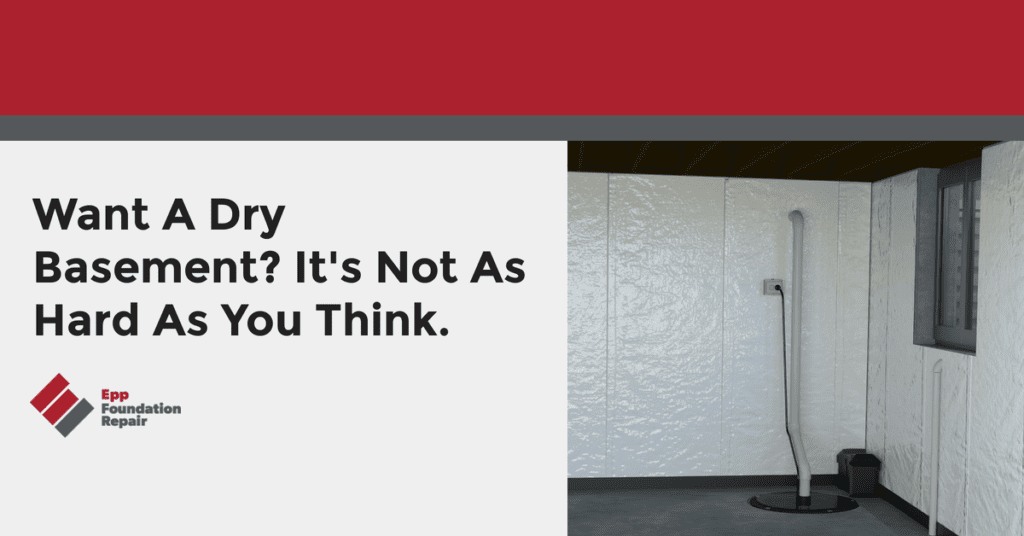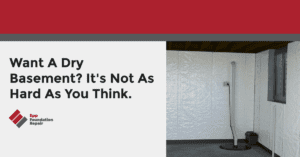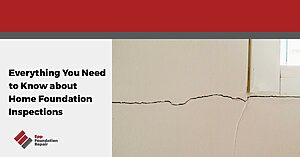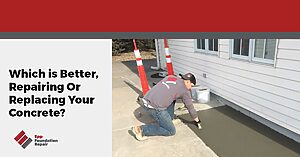Many homeowners in the Midwest just accept the idea that their basement is going to be a damp, uncomfortable space. This is unfortunate because getting a dry basement that you’ll feel comfortable spending time in, is achievable. Most problems preventing a dry basement can be repaired by an experienced basement waterproofing contractor.
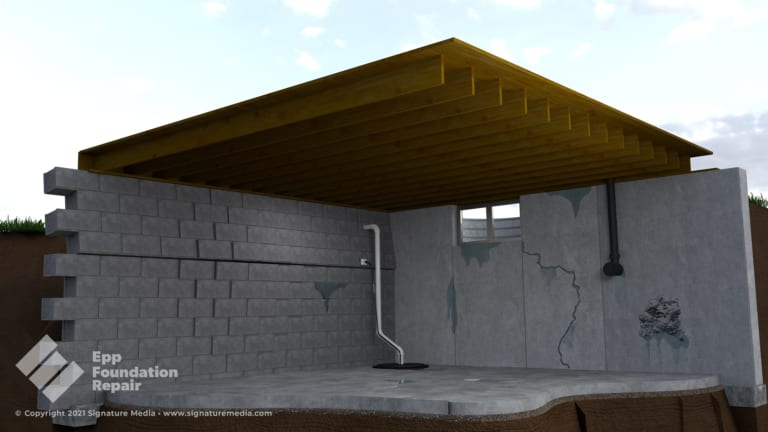
How did my basement get wet?
There are basically 10 different ways water can get into your basement:
- Your basement wall is bowed – A bowed basement wall indicates that the soil outside the wall is saturated with water that isn’t able to drain off. This creates hydrostatic pressure that pushes against the wall. If there are any small, existing cracks, hydrostatic pressure will push the water through them and into your basement. However, hydrostatic pressure can also create new cracks in your basement wall.
- You have a crack in your basement wall – If the cracks are large enough, water will be able to flow into your basement without the assistance of hydrostatic pressure.
- Your basement window is leaking – Sometimes this is a result of poor drainage in a window well.
- There’s a leaky pipe or pipe penetration in your basement wall – Sometimes, water can get in through the hole in the wall that the pipe runs through.
- There’s water seeping into your basement at the cove joint – The cove joint is the point where the basement floor and wall meet. Cove joint seepage is usually caused by hydrostatic pressure.
- There are one or more cracks in your basement floor.
- The drain in your basement floor is backed up – This means there’s a clog or other issue somewhere in the line.
- There’s seepage over the top of your basement wall – This can happen when water is pooling near your foundation. This could be caused by, among other things, improper grading or a short downspout that’s dumping water near the foundation.
- Concrete honeycombing – Concrete is already a porous substance, and honeycombing just makes it that much easier for water to penetrate it.
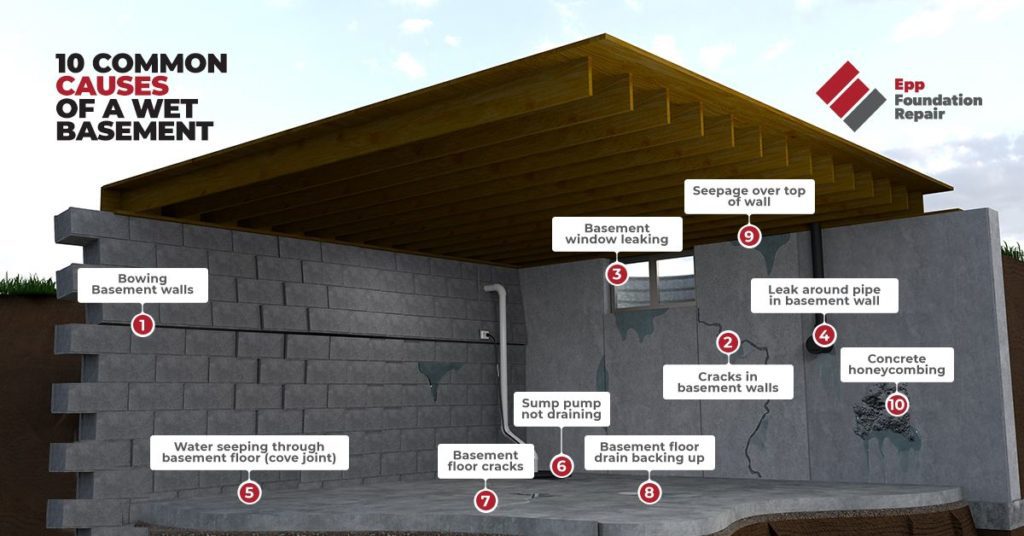
Benefits of a dry basement
The benefits of a dry basement include:
- The air inside your home will be healthier – A dry basement means lower humidity and no mold growth.
- Your energy bills may be lower – Lower humidity means your HVAC system doesn’t need to work as hard.
- It may prevent structural damage – Hydrostatic pressure, if it goes on for long enough, can cause serious damage to your foundation.
- You’ll gain valuable storage space – You won’t have to worry about water damaging items stored in your basement.
- You can have a worry-free vacation – You don’t have to worry about a surprise storm flooding your basement while you’re away.
- It increases your home’s property value – Who doesn’t want to buy a home with a dry, livable basement?
How to get a dry basement
Waterproofing a basement often involves using both an interior and an exterior solution.
Interior basement waterproofing solutions include:
- Sump pumps (with battery backup) – These are designed to prevent flooded basements. The sump pump collects the water and then, when it fills to a certain level, it kicks in and pumps the water out and away from the foundation. Having a battery backup will keep your pump working even if your power goes out during a storm.
- Drain tile system – An interior drain tile system consists of perforated piping installed in the basement floor slab, around the perimeter walls, and other areas. The perforations in the pipe allow groundwater to enter the pipe and flow into the sump pit where it is then pumped out of the basement.
- Vapor barrier – This is polyethylene (plastic) sheeting that prevents moisture diffusion through basement walls, reducing humidity in your basement.
- Dehumidifiers – Dehumidifiers in your basement are a great extra line of defense to remove any moisture in the air.
- Basement crack repair – Crack repair solutions include epoxy injection, Xypex crack repair, and carbon fiber crack repair. If there are too many cracks: A drain-tile system in conjunction with a vapor barrier can be used in situations where there are too many cracks (in poured concrete walls) to be cost-effective to fix, or if there’s a block wall and you can’t use the other crack repair options to stop a leaking crack. The drain-tile system would still allow water to enter the home but would control where that water goes by diverting it through the drain-tile to a sump pump to be removed from the home.
- Address structural issues – Many times a wet basement is caused by a structural problem. If this is the case, it will need to be fixed.
Exterior basement waterproofing solutions include:
- Yard drainage – This might include regarding your yard, and installing a French drain that will channel water away from the foundation.
- Exterior basement waterproofing membrane – This involves excavation and applying a waterproof membrane to the exterior side of the basement wall.
- Exterior foundation drain – Exterior foundation drains are typically included in the construction of the building’s footer. In other words, many houses already have them. However, if your house doesn’t, we can install one as part of an exterior waterproofing solution.
- Window well drainage – Water that collects in a window well will often find its way into the basement. Window well drains can connect directly to your interior drain tile and sump pit.
- Egress window installation – Egress windows are those that are large enough to provide an easy way to exit the basement in case of an emergency. When there are problems with a non-egress window, it is typically a good idea to upgrade to an egress window during your project. In fact, egress windows are required by code for all basement windows.
- Basement window well repair or replacement – Improper window well drainage is one-way water can get into your basement. Also, the window well itself can actually deteriorate and allow water to leak into the soil instead of draining into the sump pit. When this happens, the water can then find a way into the basement.
- Downspout extensions – Sometimes, downspouts dump water too close to the foundation. Extensions make sure that it’s deposited at a good distance away from the foundation.
Read also: How does water get into a crawl space?
How much does it cost to waterproof a basement?
The cost of basement waterproofing really depends on the problem, and whether or not the solution will be fairly simple, or complex. At Epp Foundation Repair, an average waterproofing job typically costs somewhere between $3,000 – $15,000, depending on the severity of the issue. However, if it’s just an epoxy wall injection, it will probably be much less. Unless we perform an inspection, it’s impossible to give a specific cost.
Please reach out to us for a free estimate to get accurate pricing,
If your basement has already flooded…
If the flooding is severe, don’t go down into the basement until you’re sure it’s safe. Do not touch the water. If the water has risen over even one electrical outlet, there could be a current running through it.
If you can safely do it, shut off the electricity at the main breaker. If you can’t safely do this, don’t. Call a professional that specializes in handling flooded basements immediately.
If the flooding isn’t severe, and you can safely investigate, find the source of the water. If you can’t, contact a professional that specializes in cleaning up flooded basements.
If your basement hasn’t flooded but is just wet…
A wet vacuum, or even just a mop and a bucket will get rid of floor puddles. Fans and dehumidifiers can be used to ventilate the area in order to limit mold growth.
Remove any fabric materials so they can dry out (unless they’ve been contaminated by dirty water) before mold has a chance to form on them, and inspect wood items and finishing for mold. Of course, wet drywall will need to be removed. Check out our blog post about – Basement mold types.
You don’t need to accept a damp, moldy space under your home. A dry basement is most definitely not impossible. An experienced foundation repair professional will be able to repair any problems preventing a dry basement.
If you want a dry, comfortable basement that you can use as a pleasant living space, or for safely storing valuable items, contact us today for a free estimate.
Since 1994, we’ve helped clients in Lincoln, Omaha, Kearney, Nebraska, Missouri, Iowa and parts of Northeastern Kansas with foundation repair, basement waterproofing, crawl space encapsulation, and concrete leveling for their homes.

